About Mutilated Currency
Under the Currency Act , mutilated notes and coins command no value. No person is entitled to recover from MAS the value of any mutilated note or coin. Merchants may also refuse to accept mutilated notes or coins.
MAS may, out of goodwill and at its absolute discretion, award value for a mutilated currency note or coin, provided there is no evidence suggesting that the note or coin has been wilfully or deliberately mutilated.
Note: It is an offence to mutilate any notes or coins. If you are aware of any deliberate acts of mutilation to currency, you can file a police report and inform MAS via the online feedback form .
How to Identify Mutilated Currency
Refer to the following to find out how you can identify if your note or coin is damaged.
Notes may be defined as mutilated if they are:
- Scorched or burnt.
- Attacked by pests and insects.
- Stained by ink, paint or other chemicals.
- Defaced by markings or writings of words, figures and others.
- Perforated or portions missing.
Coins may be considered mutilated or damaged if they are:
- Scorched or burnt.
- Stained by ink, paint or other chemicals.
- Defaced by stamping or engraving.
- Holed, chipped or cut.
- Dislodged (in the case of Third Series $1 bi-metallic coins).
Guidelines for Assessing Mutilated Currency Notes and Coins
Assessment criteria for mutilated notes
Mutilated notes are assessed in 2 stages.
In stage 1, the following will have to be met:
- The note has been validated to be genuine.
- There is no evidence to suggest that the note has been wilfully or deliberately damaged.
- If you have provided supporting evidence about the circumstances leading to the mutilation, the evidence will also be assessed for its reasonableness.
If all the criteria in stage 1 are met, the currency note will proceed to stage 2 assessment. In stage 2, the refund value for a mutilated note is assessed based on the portion of the note remaining according to the following guidelines:
|
Portion Remaining |
Example |
Refund value |
|
At least 2/3 of the original currency note is present |
 |
Full face value |
|
More than 1/3, but less than 2/3, of the original currency note is present |
 |
Half face value |
|
1/3 or less of the original currency note is present |
 |
No value |
- If two or more portions of a note are present, the refund value that may be paid will be assessed based on the sum of the individual portions presented, provided there is no evidence to suggest that the portions are from different notes.
- (In addition, for 1,000 and $10,000 notes) At least five complete digits or letters of both sets of serial numbers should be present before any refund value is assessed.
- A refund of up to full face value of the original note may be paid, if MAS is satisfied that the method of mutilation and supporting evidence show that the missing portions of the note have been destroyed or will not be awarded any refund value in the future.
Assessment criteria for mutilated coins
- The coin has been validated to be genuine.
- There is no evidence to suggest that the coin has been wilfully or deliberately damaged.
- If you have provided supporting evidence about the circumstances leading to the mutilation, the evidence will also be assessed for its reasonableness.
- The coin has not been damaged by being cut, chipped, holed, warped, dented or defaced.
- (For Third Series $1 bi-metallic coins) The coin has not been dislodged.
Refer to the following for examples of mutilated coins.
| Type of damage | Example |
| Holed coin | 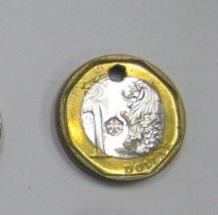 |
| Dislodged coin | 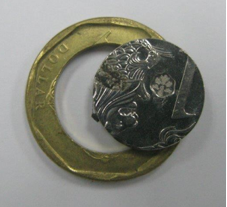 |
| Coin defaced by filing | 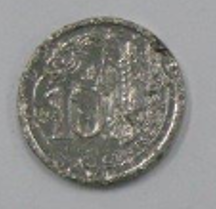 |
| Chipped coin | 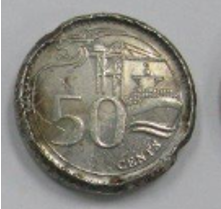 |
| Coin defaced by stamping | 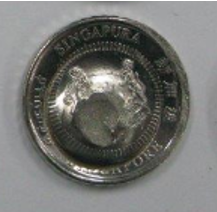 |
| Coin damaged by cutting | 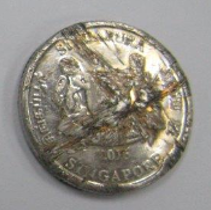 |
Note: There is no refund value for coins that are cut, chipped, holed, warped, dented, defaced or dislodged (in the case of Third Series $1 coins).
What to Do with Mutilated Notes and Coins
You may deposit mutilated notes or coins at any commercial bank where you have a bank account for assessment of value. For mutilated coins, you may also deposit them at MAS' appointed Circulation Coin Operator and Manager (CCOM), Certis CISCO Secure Logistics Pte Ltd (CSL) . The bank or CSL will credit the assessed value awarded to your bank account.
If you have problems getting the mutilated notes and coins accepted by the bank or CSL, write in to MAS via the online feedback form with the following details, where applicable:
- Name of the bank.
- The bank or CSL branch.
- The bank or CSL counter staff's name.
- The date and time you attempted to deposit the damaged currency at the bank or CSL.